Styrofoam Art Technique Easy to Draw Fastfood Drink
This post may contain affiliate links. We may earn a small commission from purchases made through them, at no additional cost to you. You help to support resin-expert.com
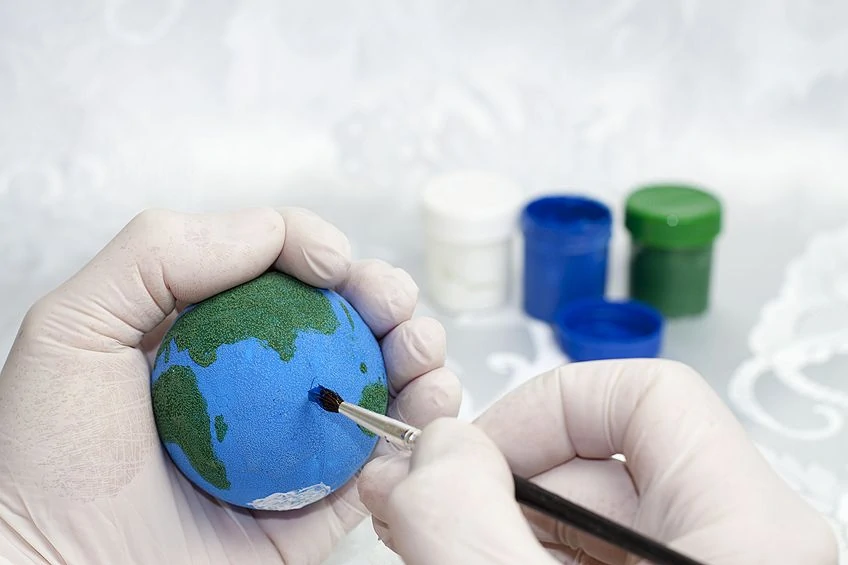
Styrofoam is light and comes in a whole range of different sizes and shapes, making it an excellent material to use for any craft project you want to get involved with. However, this is not the only purpose for Styrofoam; it is also found in the construction industry in structural, thermal, cavity, or sound insulating panels and is also used for packaging. Because it is so plain in appearance, it often requires a little touch of paint to give it some color, but to do this can be more difficult than you think. In this article, we will be answering the question of can you paint Styrofoam in all of its shapes and sizes.
Table of Contents
- 1 What Is Styrofoam?
- 2 What Paint Can Be Used for Painting Styrofoam?
- 3 Best Paint for Styrofoam
- 3.1 Best Primer for Painting Styrofoam: MONTANA Gold Tech Universal Primer Spray
- 3.2 Best Acrylic Styro Paint: CALIART Acrylic Paint Set
- 3.3 Best Sealer for Styrofoam: MOD PODGE Water-Based Sealer
- 4 How to Paint Styrofoam
- 4.1 Preparation and Materials
- 4.2 Selecting and Applying the Primer
- 4.3 Selecting and Applying the Correct Paint
- 4.4 How to Paint Styrofoam Balls
- 5 Painting Styrofoam Ceiling Tiles
- 5.1 Is It Better to Paint Ceiling Tiles in Position or Loose?
- 5.2 Prepare for Painting
- 5.3 Masking the Ceiling Area
- 5.4 Applying the Primer
- 5.5 Applying the Paint
- 5.6 Removing the Tape
- 6 Can You Spray Paint Styrofoam?
- 6.1 Spraying Styrofoam Balls
- 7 Creative ideas with Styrofoam
- 8 Frequently Asked Questions
- 8.1 Can You Paint Styrofoam?
- 8.2 Can You Spray Paint Styrofoam?
- 8.3 Can You Protect Styrofoam That Has to Stay Outdoors?
- 8.4 Is Styrofoam a Fire Hazard?
- 8.5 Is Styrofoam Environmentally Friendly?
- 8.6 Are Pool Noodles Made From Styrofoam?
What Is Styrofoam?
Styrofoam is a petroleum-based plastic that is formed from styrene monomers. Styrofoam is formed through polymerization, where styrene is refined to form polystyrene, and then a hydrofluorocarbon agent is included. This combination is then taken and extruded and permitted to expand under a certain pressure, which then forms a Styrofoam board.
Styrofoam, then, is only a brand name of closed-cell Extruded Polystyrene (XPS) foam, and is also mentioned by the name of 'Blue Board'.
There is a lot of confusion when it comes to this product as many people think what they have is Styrofoam, when in fact, it is polystyrene. Take, for example, those disposable containers like foam cups and containers used for fast foods: They are not Styrofoam (XPS) but Expanded Polystyrene (EPS). The EPS or polystyrene product is very light, made up mainly of air (95 percent), which makes it ideal for coffee cups, coolers, life jackets, packing material, and much more.
The XPS or Styrofoam product, on the other hand, is a closed-cell foam that makes it ideal for insulation, and because it is a closed-cell product, this makes it structurally very strong. If you look at EPS (Expanded Polystyrene) foam under a microscope, you will see gaps between the cells that allow air and moisture in, which also reduces its strength. The XPS or Styrofoam product will show no gaps between the cells, which gives it its strength and moisture resistance.
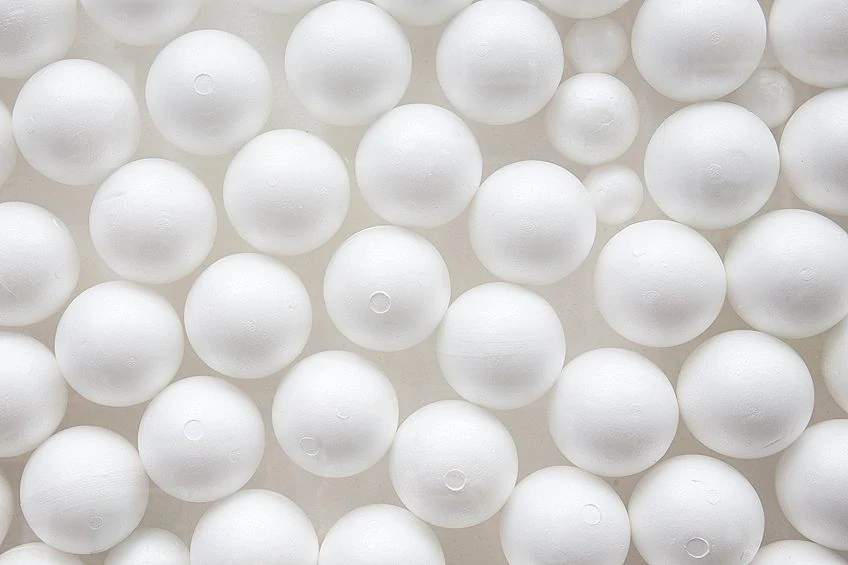
Styrofoam is also an excellent product for crafts and is used worldwide because of its versatility and how lightweight it is. So, how do you know if you have a Styrofoam product? You can do this simply by looking at the Styrofoam brand trademark, which is made by DuPont, the trademark of which is registered worldwide.
You may also be wondering whether Styrofoam is recyclable. Well, it is not biodegradable, so you cannot put it in normal recycling containers. However, it can be extruded back to form solid polystyrene pellets, which can, in turn, be used to make items like picture frames, coat hangers, fast food packaging, and much more.
What Paint Can Be Used for Painting Styrofoam?
Can you paint Styrofoam? Styro painting can be a fun activity to do with your kids, or as one of your craft projects. However, if you do not follow the correct process, it can cause your project to fail miserably.
The very first point to consider is using the right type of paint. This means that only craft paints or Styrofoam paints can be used, and these must specifically state that they can work well on Styrofoam. The best paint to use when Styro painting is acrylic or water-based paint. This paint will not damage the Styrofoam in any way and will stick properly to the surface. You will also have plenty of colors to choose from.
There are many types of paint out there that contain chemicals or solvents like acetone, toluene, tetrahydrofuran, or benzene. Using these paints on your Styrofoam will cause the chemicals to dissolve or melt the material, leaving huge craters or holes, rendering your project useless. We advise you not to use any of these paints for painting Styrofoam.
Best Paint for Styrofoam
As mentioned, your acrylic or water-based paints are best for Styrofoam, as anything else will damage the Styrofoam. Below are a few recommended products to help you select what you need more easily. We have chosen the best primer, acrylic paint, and a popular sealer.

Best Primer for Painting Styrofoam: MONTANA Gold Tech Universal Primer Spray
This primer spray by the renowned Montana brand has been specially formulated for use on hard-to-treat surfaces like styrofoam, plastic, and metal, as well many other surfaces. Thus, you will be able to achieve top-quality adhesion when applying this primer, which will allow you to apply your choice of acrylic paints. Once dry, you will be able to sand and recoat the primer if necessary with great ease.

- Enables excellent adhesion and coating of acrylic paints
- Can be used on surfaces that need pretreating, like styrofoam
- Easy to use with more efficient and permanent results
View on Amazon
PROS
- Great for difficult-to-paint surfaces
- Provides a smooth, adhesive finish
- Primer can be sanded once dry
- Leaves a beautiful, glossy finish
CONS
- One user complained that it is too thin (thus, you will require multiple coats)
Best Acrylic Styro Paint: CALIART Acrylic Paint Set
These premium, artist-quality acrylic paints by Caliart are an excellent choice for all your Styrofoam painting requirements. With a wide range of 24 vibrant and highly pigmented colors, this set is ideal for use by both beginners and professionals. The paints themselves are water-based and non-toxic, making them completely safe to use, and the creamy consistency will allow for smooth application.
You will notice how beautifully the colors blend and how well they cover the surface. The quick-drying formula will allow you to apply as many coats as you need to your piece without having to wait for too long, and you will be able to clean up any messes simply with some water and soap. You can expect these vibrant colors to remain as vivid and bold as the first day they were painted, making for a long-lasting masterpiece.

- Premium paints glide on smoothly, dry quickly, and stay beautiful
- High pigmentation and creamy consistency provide great coverage
- Fast-dry formula and easy clean-up with soap and water
View on Amazon
PROS
- Wide range of colors
- Colors are highly pigmented and will not fade
- Easy and smooth application
- Great coverage and blending ability
- Quick-drying
- Excellent value for money
CONS
- Packaging is not of the best quality
Best Sealer for Styrofoam: MOD PODGE Water-Based Sealer
Mod Podge is famous for its all-in-one sealer, glue, and finish formulation, allowing you to provide a clear protective finish to your acrylic Styrofoam masterpiece. This water-based sealer is non-toxic and will dry quickly, meaning that you will be able to apply several coats. Once dry, you will be left with a matte finish that you can then sand down if required. Apply this product easily with a brush or a sponge, and clean up any fresh messes easily by using some soapy water.

- Multipurpose, all-in-one sealant, glue, and finish (matte finish)
- Quick-drying for building up multiple coats and dries clear
- Water-based, non-toxic, and easy to clean with soap and water
View on Amazon
PROS
- Safe to use and non-toxic
- Easy to apply
- Provides a water-resistant coat
- Works great on porous surfaces
- Affordable
- Comes in different finishes
CONS
- Cannot be used on outdoor surfaces
- May not adhere to certain surfaces
How to Paint Styrofoam
Painting Styrofoam can prove to be a little tricky if you do not follow certain rules. The very first and most important of these rules is to select the correct type of primer as well as paint. We will now be taking you through the process step by step, ensuring that you have a perfect job when done.
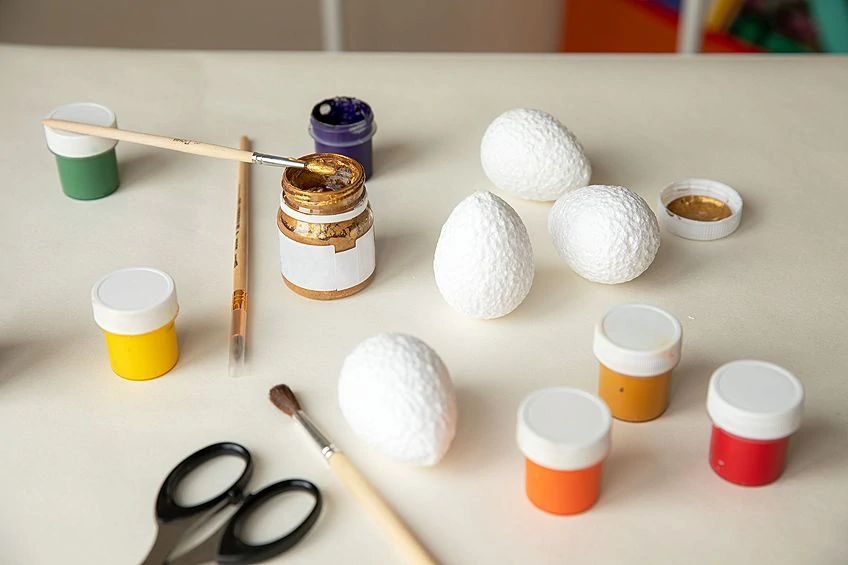
Preparation and Materials
The very first step is to get all the materials you need together in one place. Take your old newspapers and cover your working area or table to ensure that no paint will mess on that area. You will require the following materials for painting Styrofoam:
- Old Newspapers
- Acrylic or Latex primer
- Disposable cups and paper plates
- Paintbrush
- Crafters acrylic paint
- Foam brush
Selecting and Applying the Primer
It is not always necessary to use a primer before you paint Styrofoam, but it will help to give you a smoother finish, especially if the paint you are going to use is not Styrofoam friendly and does not adhere well. Primers you can use successfully are plaster of Paris, mod podge, surface textures, or best of all, a foam finish.
Let us now consider how to seal Styrofoam before painting in order to prime the surface. Utilizing your foam or regular paintbrush, spread a thin layer of primer and allow it to dry properly. This will fill up any cracks that your Styrofoam may have and will provide you with a solid base that you can then paint over.
Now, if it is necessary, use some fine sandpaper to remove any rough spots until the surface is completely smooth. You can now apply a second coat, allow it to dry, and sand again if necessary. Your Styrofoam shape should now have a strong seal and be ready for painting.
Selecting and Applying the Correct Paint
Acrylic paint on Styrofoam for crafting is best, so be sure to get it in the color that you want for your project. Buy enough paint to cover the whole project, as you do not want to have to return to the store before your project is finished.
If you are going to paint a few small Styrofoam balls or other small objects, you will probably need a small bottle, which is around two ounces of paint. For larger projects, you need to buy bigger containers, and make sure that you have enough for two coats of paint.
Avoid using regular spray paints like enamels, as they will eat the Styrofoam away.
Pour only a small amount of paint onto a paper plate or into a disposable cup and dip your foam brush or soft-bristled paintbrush into the paint. Make sure that there is only a small amount of paint on the brush. Now apply the paint to the Styrofoam in even layers, using even strokes until you have covered the entire shape. Make sure that you cover any spots or cracks.
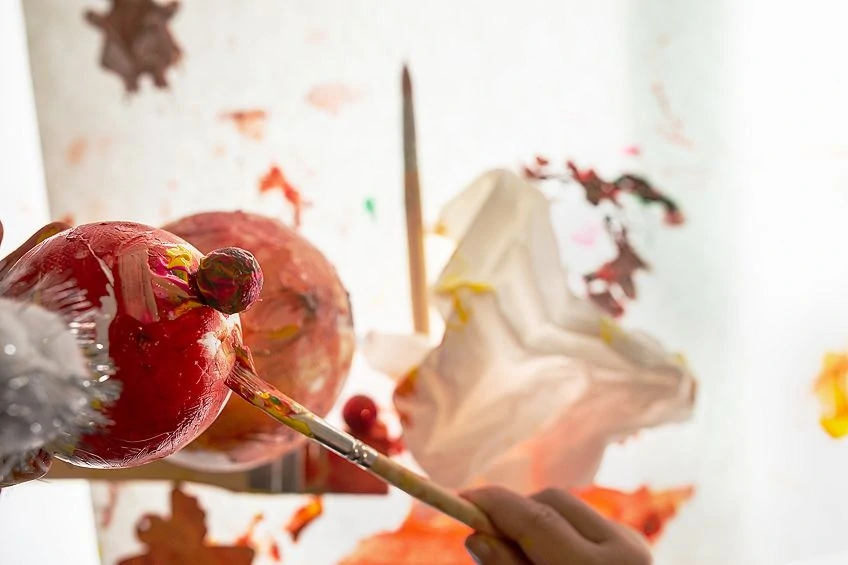
Allow the paint to dry for about 10 to 20 minutes, and then check to see if there are any white specks still visible – you will likely need to apply a second coat. As soon as the second coat is dry, you can apply a third coat until you are satisfied with the finish. You need to make sure that the paint has adhered properly to the Styrofoam and has covered the entire surface, or else the paint can start peeling off.
Lastly, do you need to apply a top or sealing coat over the paint? If you have applied a sufficient number of coats of paint over your Styrofoam, it should not be necessary to apply a top or sealing coat. However, if you want to make your project completely waterproof, then you can apply a topcoat, as acrylic paint on styrofoam (as well as other paints) are not waterproof.
For this purpose, many have suggested the use of a clear aerosol topcoat or a thin layer of wood glue mixed with water.
How to Paint Styrofoam Balls
After painting Styrofoam balls, you can use them for numerous craft projects, such as for dioramas of the planets or turning them into funny heads with eyes glued onto them. You can also make snowmen, or for kids, you can create a world atlas, different types of sports balls, cupcake ornaments, and the list can go on and on.
If you are wondering how to paint Styrofoam balls, all you need to do is follow the process recorded above. However, many people have found that the Styrofoam balls are not smooth enough to paint, so here are a few of their suggestions:
- Glue a piece of smooth fabric over the ball to make it easier to work with.
- Try using Gesso as a primer, as it will dry to a very smooth finish.
- Use tissue paper and glueto create a smooth surface.
- Lightly rub the Styrofoam ball with another Styrofoam ball until you have a smooth finish.
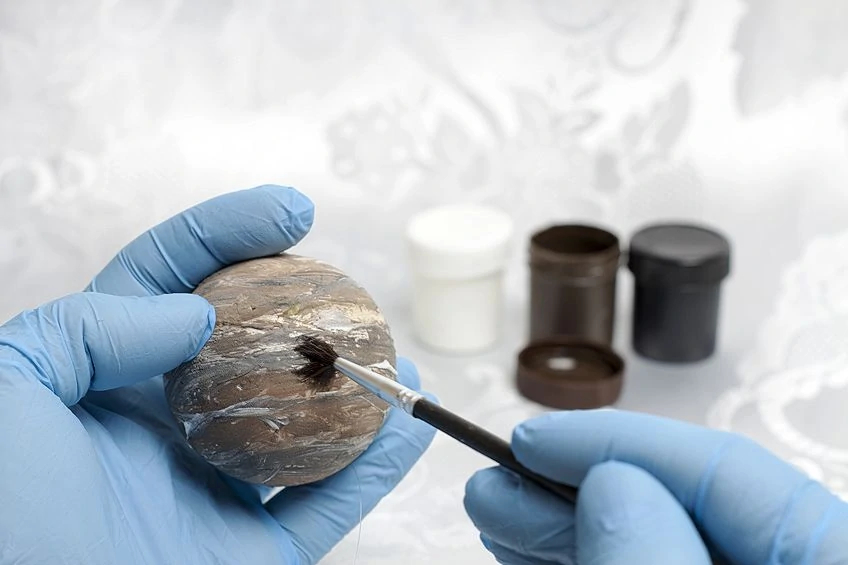
Painting Styrofoam Ceiling Tiles
One of the great advantages of Styrofoam ceiling tiles is that you can paint them once you are tired of the old look. You can even personalize them to suit your own style as well as the room they are in. So, if you are planning to paint your Styrofoam ceiling tiles, we are here to help you create the perfect job. All you need to do is follow these few steps for the best results.
Is It Better to Paint Ceiling Tiles in Position or Loose?
Both of these choices have their advantages and disadvantages. If you choose to paint them by first removing them, it may be a much easier way of doing the job, as you can paint them on the ground. However, you will need a very large space to lay them out to dry, which could take several hours. You will also need to paint the metal securing strips to match your tiles. However, if you choose to paint them while they are in position, it may be difficult to paint so high over your head.
Materials You Will Need
- Broom
- Cloths
- Painter's tape
- 3-inch polyester paintbrush
- Primer
- 5-gallon bucket
- Roller frame
- Wooden stirring stick
- Roller extension pole
- Roller cover
- Stepladder
- Goggles
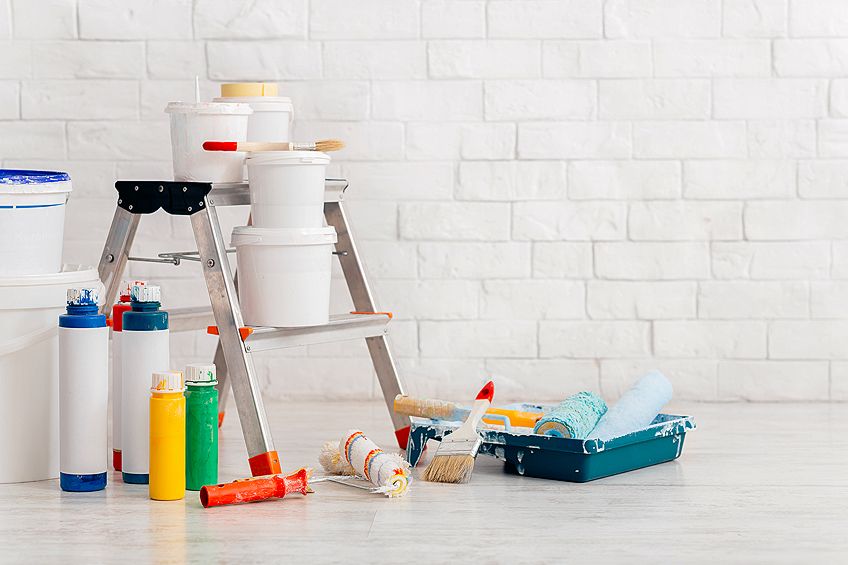
Prepare for Painting
Remove all furniture from the room and spread some plastic sheeting over the entire floor area to protect everything from any paint spills. If you are not able to remove all the furniture, ensure that the remaining pieces are properly covered. Make use of a soft broom to remove any dust that has collected on the surface of the tiles.
Masking the Ceiling Area
To protect your walls from any paint splatter, you need to apply some painter's tape along the entire length of the walls. The tape also needs to be applied in any area of the ceiling you do not want the paint to reach.
Applying the Primer
How to seal Styrofoam? It is always advisable to apply a primer before you apply the paint. Make sure that you use the right type of primer, as the tiles are made from Styrofoam. Thus, you will need to use a water-based primer, as any other primer that contains chemicals will damage your ceiling tiles.
Now you are ready to apply the primer using a paint roller for the larger areas and a paintbrush for the difficult sections you cannot reach. The paintbrush also comes in handy for removing any paint in areas where it starts to drip. Allow the primer to dry for around two to three hours before you start to paint. Remember to wash your roller and brush straight away with some water.
Applying the Paint
When the primer is dry, you can start painting. The same applies to the paint as with the primer – it needs to be painted with a water base as opposed to a chemical or solvent one. You can use the same method of application as with the primer. Use the roller for the large surfaces and the paintbrush for the areas where the roller cannot reach. Make sure that you cover the entire surface area of the ceiling with an even coat and leave it to dry, which should take around two to three hours.
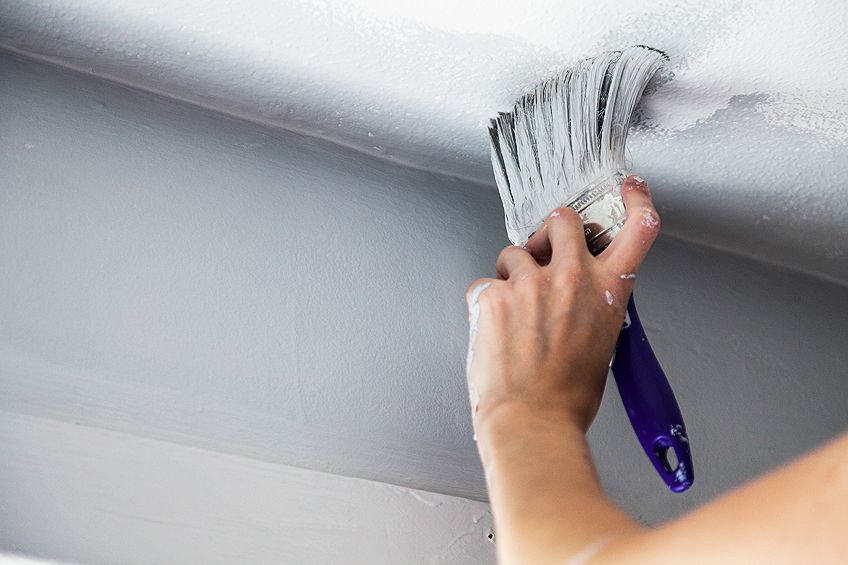
Removing the Tape
Be sure to remove the tape before the paint has properly dried or else you may find the paint coming off with the tape when it is removed. Examine the entire room to see if any paint has landed on the walls and remove it immediately using some water. You can now uncover your furniture and return the furniture you removed.
Can You Spray Paint Styrofoam?
When sculpting different shapes out of Styrofoam, you may be faced with the dilemma of how to paint something without damaging it in any way. Firstly, there are various painting methods you could use such as brushes, rollers, sponges, and also airbrushes or paint sprayers. Spraying your sculpture is an excellent option, especially if there are intricate sections that are difficult to reach with a brush.
So, if you have small items that are difficult to hold and paint by hand, or if you have a very large area, then using a paint sprayer or airbrush is the answer.
However, you need to ensure that you use the correct type of paint, otherwise, you will end up with a melted mass of plastic that will be useless for any purpose. The only paint you can use to spray with is acrylic water-based or latex paint, which must be applied in thin layers. By using an airbrush or paint sprayer, you will always be able to layer the paint in thin coatings, thus producing an even, smooth finish.
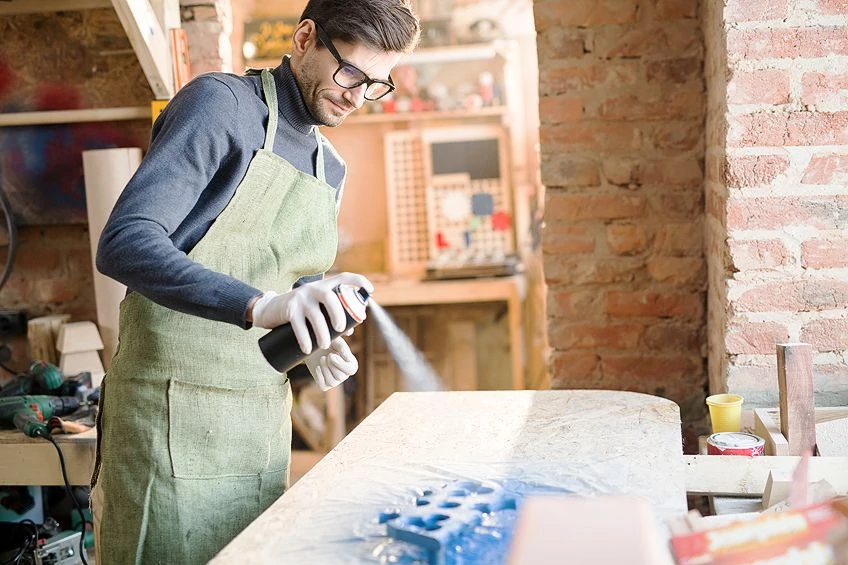
Spraying Styrofoam Balls
Painting your Styrofoam balls can be a daunting task, as it is very difficult to hold it in one hand and paint it with the other hand. You usually end up with paint all over your hands and missed spots on the ball that has no paint. So, using an airbrush or paint sprayer may just be the answer to making this difficult task a lot easier. We will now show you how to paint Styrofoam balls by using a paint sprayer.
- Use a wooden skewer and place it into the ball.
- Hold onto the other end of the skewer and start spraying the ball with the paint. Try to hold the sprayer about eight inches away from the ball so as to avoid the paint from dripping. After the first coat, it may not cover the ball properly.
- Allow the paint to dry for around 10 to 20 minutes by placing the skewer onto a holder, ensuring that it does not move during the drying stage.
- You can now apply another coat of paint, and you can keep doing so until you are satisfied that the whole ball is properly covered.
Creative ideas with Styrofoam
- Craft a pumpkin out of Stytorofoam
- Carve out wall art with letters and stencils
- Create pin cushion flowers
The sky is the limit – styrofoam is a quite diverse material you can use for all kind of crafting projects.
Frequently Asked Questions
Can You Paint Styrofoam?
Yes, but you need to take special care and use the correct type of paint. You should only use craft paints or Styrofoam paints that state specifically that they can be used on Styrofoam. You can also use acrylic paint or latex paint to paint Styrofoam, as they will not damage the Styrofoam. Avoid using chemical- or solvent-based paints, as they will damage or eat the Styrofoam away.
Can You Spray Paint Styrofoam?
Yes, spray painting Styrofoam gives you a much smoother and more even finish. Spraying can be used where a brush cannot reach or where the surface area is very large. Again, take care to use paint that is compatible with Styrofoam.
Can You Protect Styrofoam That Has to Stay Outdoors?
You can apply a sealant or topcoat to the paint, which makes it waterproof. There is also an Exterior Foam Coat available that is ideal for use on outdoor Styrofoam.
Is Styrofoam a Fire Hazard?
Styrofoam is used in large auditoriums and theaters worldwide as backdrops or props and is considered fire safe. If an open flame is held directly over the Styrofoam, it will start to melt, but as soon as the fire is removed, it will stop melting.
Is Styrofoam Environmentally Friendly?
Styrofoam is not biodegradable, however, it can be recycled and made into solid polystyrene pellets. These pellets are used to make various products like containers for the fast-food industry.
Are Pool Noodles Made From Styrofoam?
No, pool noodles are not made from Styrofoam but polyethylene foam.
Source: https://resin-expert.com/en/guide/how-to-paint-styrofoam
0 Response to "Styrofoam Art Technique Easy to Draw Fastfood Drink"
Post a Comment